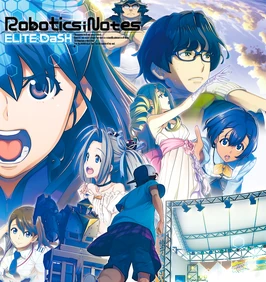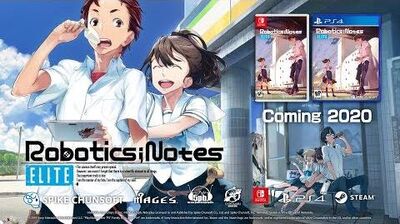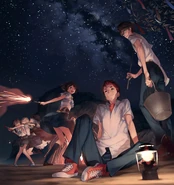| This page uses Creative Commons Licensed content from Wikipedia (view authors). |
|
"The science itself may prove cynical. However, one mustn't forget that there is a scientific element in all things. The important truth is this: I am the master of my fate, I am the captain of my soul."
Robotics;Notes (ロボティクス・ノーツ, ロボノ, Robotikusu Nōtsu) is the third main entry in the Science Adventure Series. It originally released for the PlayStation 3 and the Xbox 360 in 2012. Described as an "Augmented Science Adventure", Robotics;Notes features robotics and augmented reality as its main themes. The gameplay revolves around the use of a mobile phone/tablet hybrid called the "PhoneDroid" (also known as the "PokeCom").
Unlike its predecessors Chaos;Head and Steins;Gate, Robotics;Notes uses 3D models for its characters rather than sprites. This allows characters to fluidly shift between poses via animation while engaging in conversations with the protagonist.
In 2014, an improved version of the game titled Robotics;Notes Elite was released for PlayStation Vita. It featured a revised script, animated cutscenes, and improved character models. This version was later ported to the Nintendo Switch and PlayStation 4 in 2019. An English localization of Robotics;Notes Elite has been developed, and was released on October 13, 2020 for the Nintendo Switch, PlayStation 4, and PC via Steam (also bringing the Japanese game to PC via Steam on the same date).
Robotics;Notes DaSH, the sequel to Robotics;Notes Elite, released in Japan for the Nintendo Switch and PlayStation 4 on January 31, 2019. Its English localization has been developed, and was released on October 13, 2020 for the Nintendo Switch, PlayStation 4, and PC via Steam.
Plot overview[]
Thanks to the rising popularity of the PhoneDroid—a device which features augmented reality (A.R.)—the age of advanced technology has finally reached Tanegashima. On that island, Chuo Tanegashima High’s Robot Research Club is about to have their club disbanded. Despite their predicament, Kaito Yashio, one of only two members in the Robot Research Club, couldn’t care less and would rather play the robot fighting game Kill-Ballad all day. His counterpart, the reckless club leader Akiho Senomiya, ignores Kaito’s apathy as she strives to keep the club from being disbanded by completing their giant robot.
One day, Kaito discovers a mysterious A.R. annotation titled “Kimijima Report.” It contains instructions involving locations all across the island—and warns of a conspiracy involving the entire world.[1]
Gameplay[]
Robotics;Notes’ gameplay requires little player interaction as much of the game's content involves reading and advancing the text that appears on the screen, which represents the story's narrative and dialogue. The text is accompanied by animated 3D character models, which represent characters that Kaito or Akiho are talking to, and a wide variety of background artwork that represent different locations. The player encounters CG artwork at certain points throughout the story, which take the place of the background art and character models—this artwork typically serves to provide a more specific depiction of what is occurring in the relevant scene. Robotics;Notes follows a branching plot line with multiple endings, and depending on the decisions that the player makes during the game, the plot will progress in a specific direction.
Unlike other visual novels, in Robotics;Notes the story is completely linear, and outside of the basic “common” ending, all other endings are canon, and happen in a chronological order. They are more akin to normal, individual phases than endings in that regard. However, despite occurring in a linear path, it is possible to play them out of chronological order by not responding to Twipo tweeps correctly.
Throughout the narrative sequences in which the player follows Kaito, the player may activate the PhoneDroid Trigger (ポケコントリガー Pokekon Torigā), which allows the player to use a variety of applications installed on Kaito's tablet computer. These applications include Deluoode Map, a map application; Twipo (ツイぽ Tsuipo), a Twitter-like social networking application which the player may use to reply to other characters' tweets with predetermined responses; and Iru-o (居る夫。 Iruo.), an augmented reality image recognition application which the player may use to examine the environment and information tagged on characters or objects.
Development and release[]
The game’s PlayStation 3 and Xbox 360 opening theme, “Kakuchou Place” (拡張プレイス, Kakuchō Pureisu, Augmented Place), was written by Chiyomaru Shikura and performed by Zwei. Its true ending theme, “Sora no Shita no Soukanzu” (空の下の相関図, Correlation Diagram Under the Sky), was written by Chiyomaru Shikura and performed by Kanako Itō. Its normal ending theme, “Hagane no Yoroi Matou, Sanbyaku no Daishisai” (鋼の鎧纏う、三百の大司祭; Clad in Steel Armor, High Priest of the 300) was performed by FES (real name Yui Sakakibara) and the band Phantasm. The opening theme for Robotics;Notes Elite on PlayStation Vita and other platforms Robotics;Notes Elite has been ported to (Nintendo Switch, PlayStation 4 and Windows PC via Steam) is “Yakusoku no Augment” (約束のオーグメント, Yakusoku no Ōgumento, The Promised Augment), performed by Zwei.
The planning, original concept, and basic story of Robotics;Notes was headed by MAGES. CEO Chiyomaru Shikura. Naotaka Hayashi was the scenario writer for the game, and Tatsuya Matsubara was the game's producer. The character designs were done by Tomonori Fukuda, and the mechanical designs were done by Makoto Ishiwata. The composer of the game's music was Takeshi Abo. Shikura had been working on the game since as early as July 2010. The team received development support from the Japan Aerospace Exploration Agency, and according to Shikura, this allowed the game's science and themes to better reflect reality. Nitroplus also provided assistance with the game. Robotics;Notes features 3D visuals, and the development team aimed to use high quality 3D models seen in games such as Catherine and Idolmaster 2. The game is described by the developers as an "Augmented Science Adventure" (拡張科学アドベンチャー Kakuchō Kagaku Adobenchā).
Robotics;Notes was announced on 5pb.'s official website on December 22, 2010, noting that details about the game would appear in an interview with Chiyomaru Shikura featured in the issue of the Famitsu magazine that was being sold on the same day. Robotics;Notes was to be the third entry in the Science Adventure series, following the release of Chaos;Head in 2008 and Steins;Gate in 2009. When the target platform for the game had not yet been announced, Shikura stated that the team would not let down the fans who had supported their past works in the Science Adventure Series. He also stated that said they were aiming for a release sometime in 2011.

The poster for the english Double Pack release of ELITE and DaSH.
Robotics;Notes Elite & DaSH[]
After some delay, the game was released for both the PlayStation 3 and Xbox 360 on June 28, 2012. The PlayStation 3 version had support for Remote Play with the PlayStation Vita. An expanded PlayStation Vita port of the game was released on June 26, 2014 under the title Robotics;Notes Elite. It featured a variety of quality of life upgrades, such as animated cutscenes and script revisions. Characters in Elite were also remodeled to improve visual quality. A Nintendo Switch version of Robotics;Notes Elite was informally announced by Shikura via a live stream in 2018; both the Nintendo Switch version and the PlayStation 4 version were released on January 31, 2019. It was distributed physically in a double pack with its sequel, Robotics;Notes DaSH, and separately by digital purchase.
In 2018, Shikura stated that a Western release of the game was under consideration. English versions of Robotics;Notes Elite and Robotics;Notes DaSH were announced by Spike Chunsoft at Anime Expo 2019, then released October 13, 2020.
Reception[]
Famitsu gave the PlayStation Vita port of Robotics;Notes Elite a review score of 30/40. Japanese pre-orders for the original release of the game were over 80,000, a large increase over the preorders for Steins;Gate, the previous game in the series. Neither Famitsu nor Media Create revealed sales numbers for the Robotics;Notes Elite and Robotics;Notes DaSH double pack bundle for the PlayStation 4 and Nintendo Switch as part of their weekly sales charts, although Media Create listed both as ranking higher in sales than the Nintendo Switch standalone version of DaSH, which sold 2,834 physical copies in its launch week.
When the English localization of Robotics;Notes released in western countries some fans expressed disappointment with the translation quality. In order to mitigate the perceived flaws, a group created a fan patch.
Opening Movies[]
Media[]

Robotics;Notes Elite Announcement Trailer
















